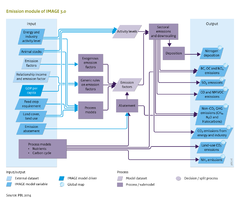Emissions/Description: Difference between revisions
Jump to navigation
Jump to search
Oostenrijr (talk | contribs) m (Text replace - "NH3" to "NH<sub>3</sub>") |
Oostenrijr (talk | contribs) No edit summary |
||
| Line 59: | Line 59: | ||
===Land-use related emissions=== | ===Land-use related emissions=== | ||
CO<sub>2</sub> exchanges between terrestrial ecosystems and the atmosphere computed by the LPJ model are described in [[Carbon cycle and natural vegetation]]. The land-use emissions model focuses on emissions of other compounds, including greenhouse gases (CH<sub>4</sub>, N<sub>2</sub>O), ozone precursors (NO<sub>x</sub>, CO, NMVOC), acidifying compounds (SO<sub>2</sub>, NH<sub>3</sub>) and aerosols (SO<sub>2</sub>, | CO<sub>2</sub> exchanges between terrestrial ecosystems and the atmosphere computed by the LPJ model are described in [[Carbon cycle and natural vegetation]]. The land-use emissions model focuses on emissions of other compounds, including greenhouse gases (CH<sub>4</sub>, N<sub>2</sub>O), ozone precursors (NO<sub>x</sub>, CO, NMVOC), acidifying compounds (SO<sub>2</sub>, NH<sub>3</sub>) and aerosols (SO<sub>2</sub>, NO<sub>3</sub>, BC, OC). | ||
For many sources, the emission factor ([[#General approaches|Equation 1]]) is used ([[Emission table]]). Most emission factors for anthropogenic sources are from the [[EDGAR database]], with time-dependent values for historical years. In the scenario period, most emission factors are constant, except for explicit climate abatement policies (see below). | For many sources, the emission factor ([[#General approaches|Equation 1]]) is used ([[Emission table]]). Most emission factors for anthropogenic sources are from the [[EDGAR database]], with time-dependent values for historical years. In the scenario period, most emission factors are constant, except for explicit climate abatement policies (see below). | ||
| Line 77: | Line 77: | ||
===Emission abatement=== | ===Emission abatement=== | ||
Emissions from energy, industry, agriculture, waste and land-use sources are also expected to vary in future years, as a result of climate policy. This is described using abatement coefficients, the values of which depend on the scenario assumptions and the stringency of climate policy described in the climate policy component. In scenarios with climate change or sustainability as the key feature in the storyline, abatement is more important than in business-as-usual scenarios. Abatement factors are used for CH<sub>4</sub> emissions from fossil fuel production and transport, N<sub>2</sub>O emissions from transport, CH<sub>4</sub> emissions from enteric fermentation and animal waste, and N<sub>2</sub>O emissions from animal waste according to the IPCC method. These abatement files are calculated in the IMAGE climate policy sub-model FAIR (Component [[Climate policy]]) by comparing the costs of non-CO<sub>2</sub> abatement in agriculture and other mitigation options. | Emissions from energy, industry, agriculture, waste and land-use sources are also expected to vary in future years, as a result of climate policy. This is described using abatement coefficients, the values of which depend on the scenario assumptions and the stringency of climate policy described in the climate policy component. In scenarios with climate change or sustainability as the key feature in the storyline, abatement is more important than in business-as-usual scenarios. Abatement factors are used for CH<sub>4</sub> emissions from fossil fuel production and transport, N<sub>2</sub>O emissions from transport, CH<sub>4</sub> emissions from enteric fermentation and animal waste, and N<sub>2</sub>O emissions from animal waste according to the IPCC method. These abatement files are calculated in the IMAGE climate policy sub-model FAIR (Component [[Climate policy]]) by comparing the costs of non-CO<sub>2</sub> abatement in agriculture and other mitigation options. | ||
}} | }} | ||
Revision as of 10:52, 1 July 2014
Parts of Emissions/Description
| Component is implemented in: |
Components:and
|
| Projects/Applications |
| Models/Databases |
| Key publications |
| References |
|
